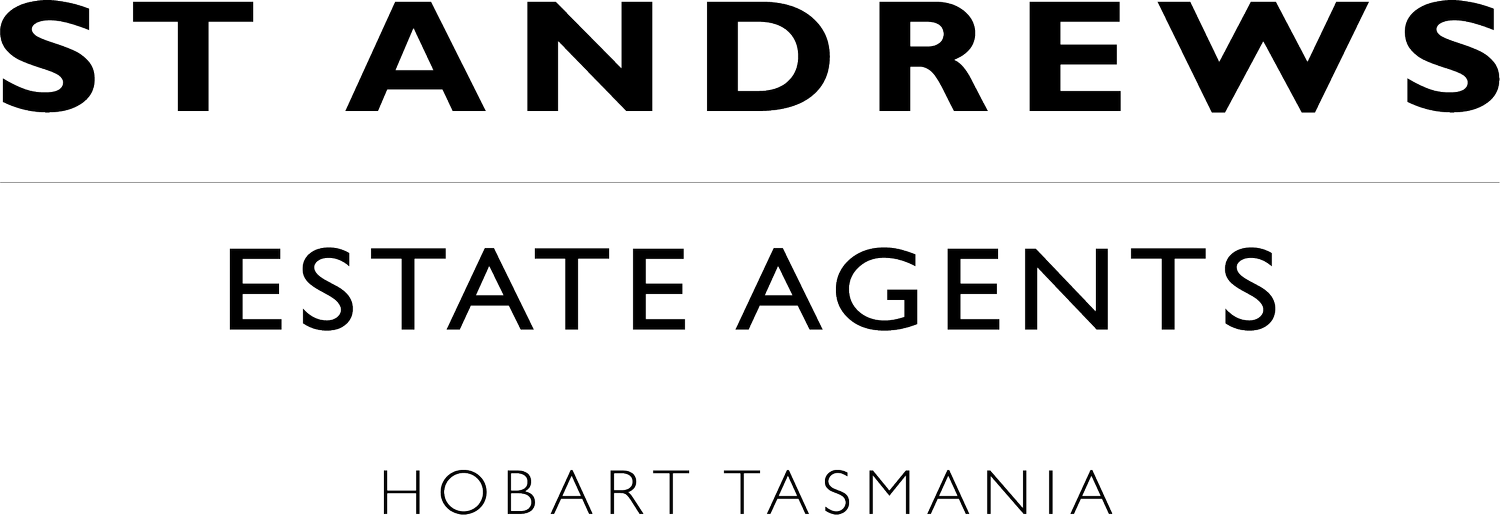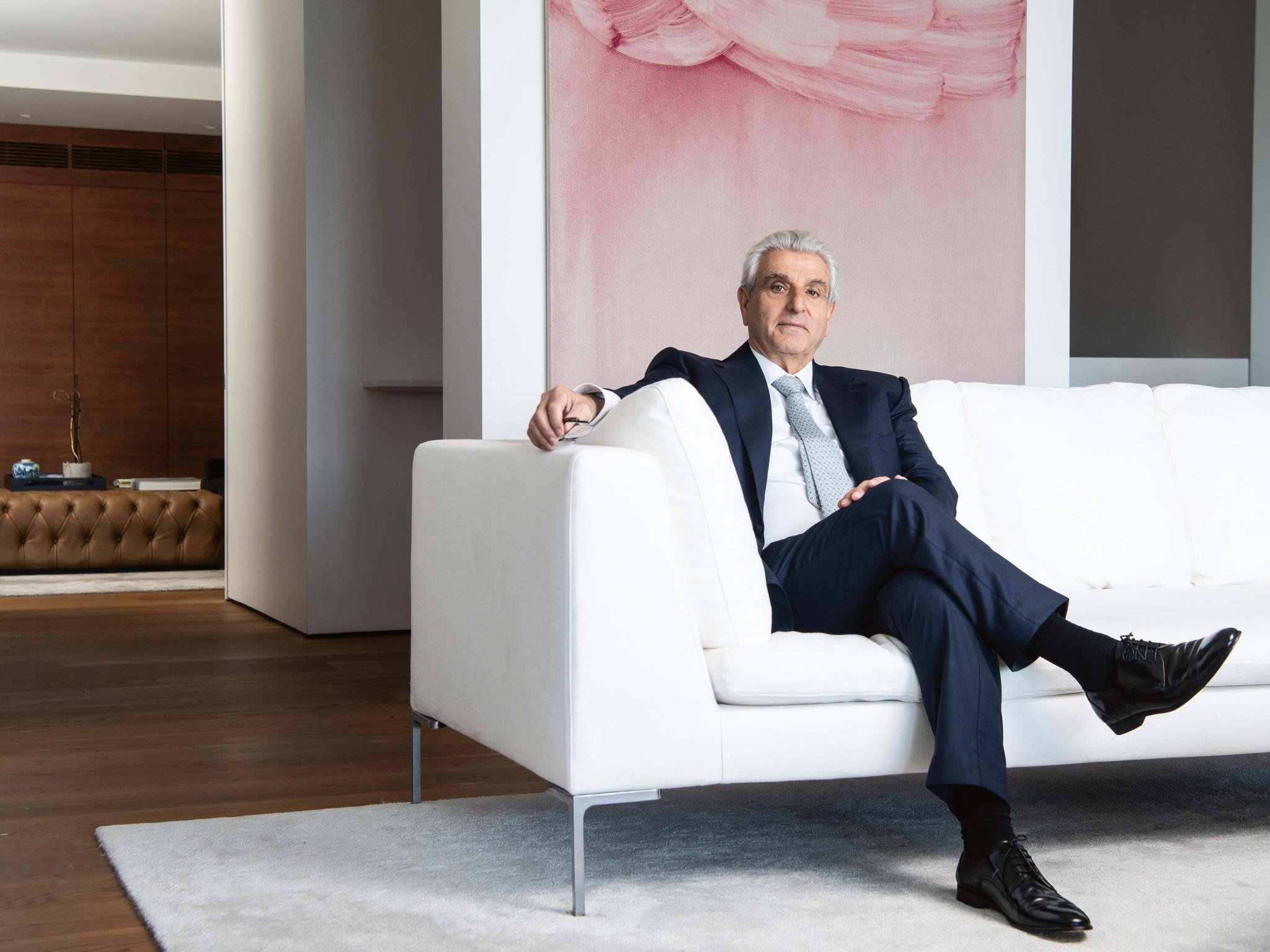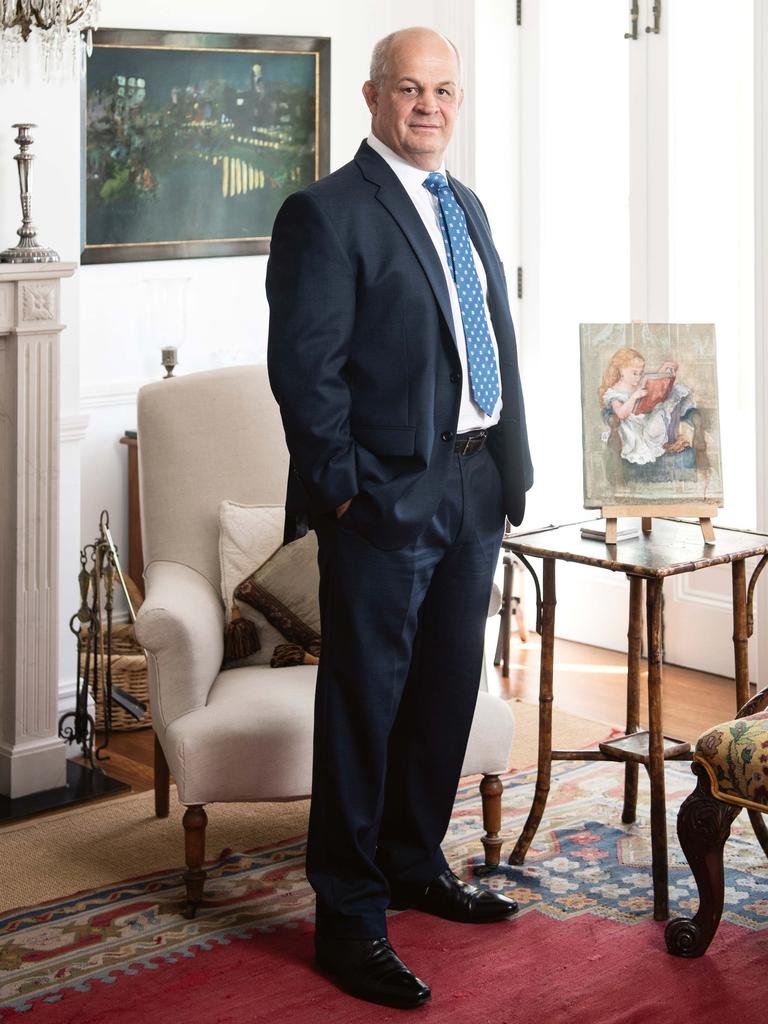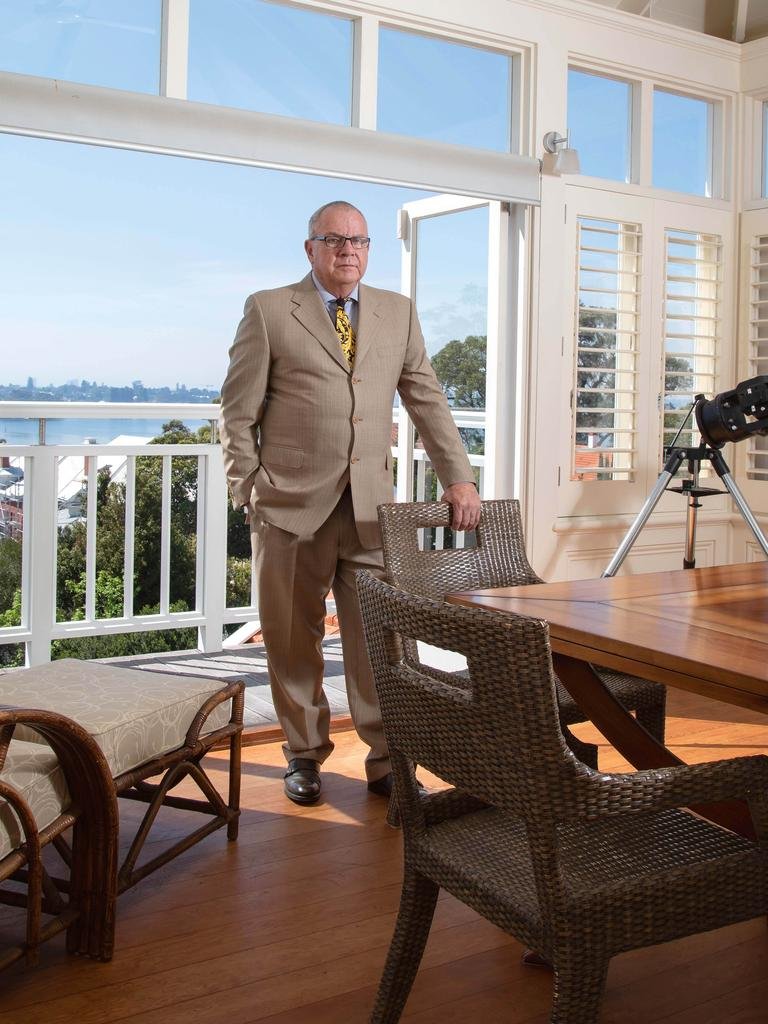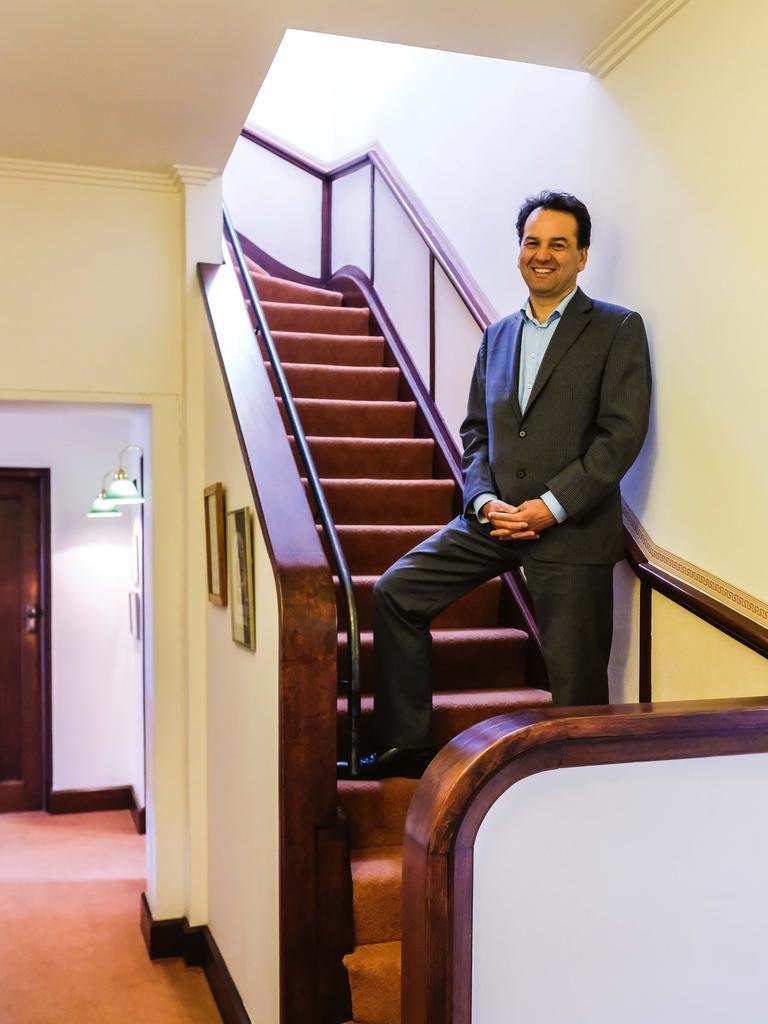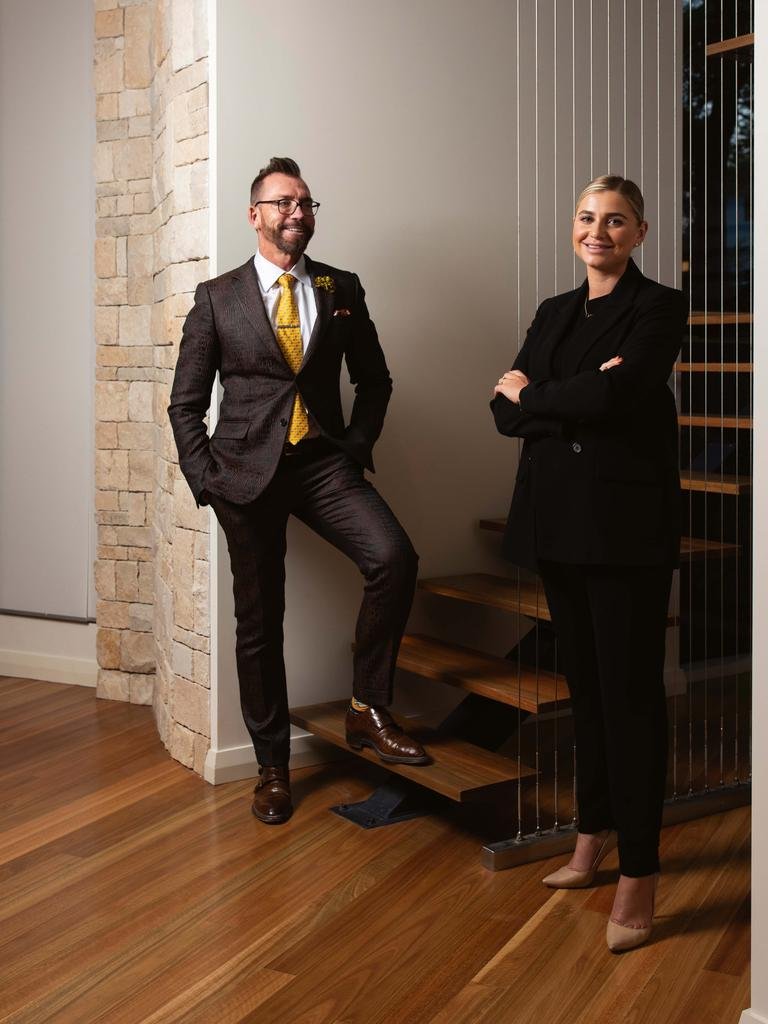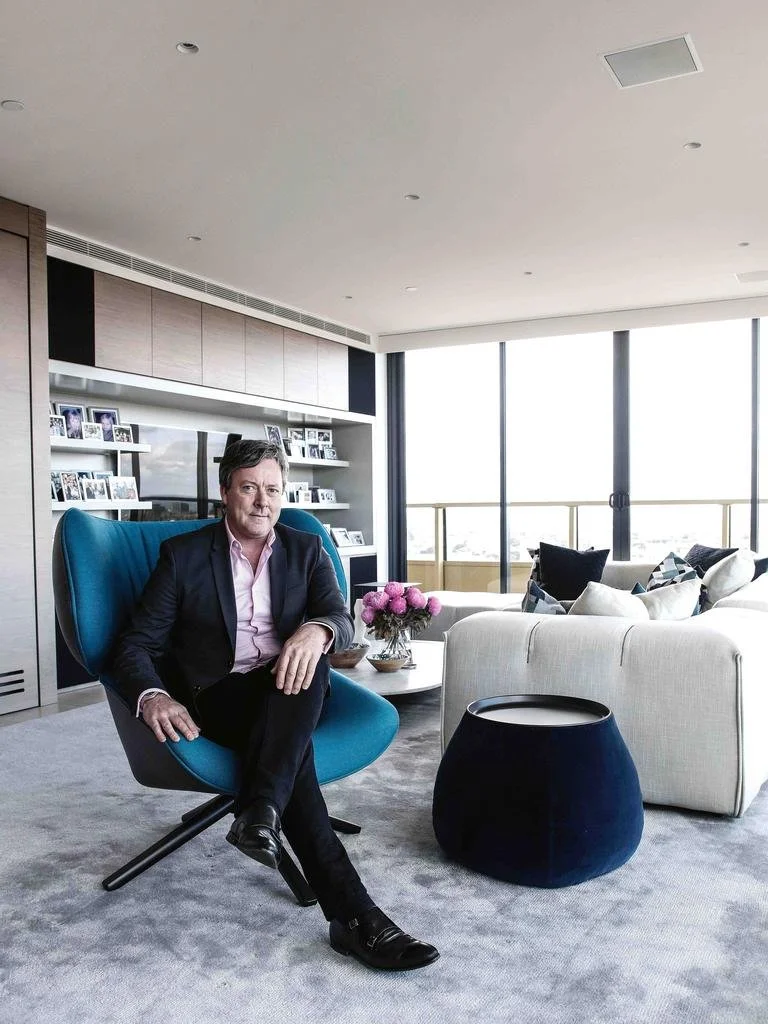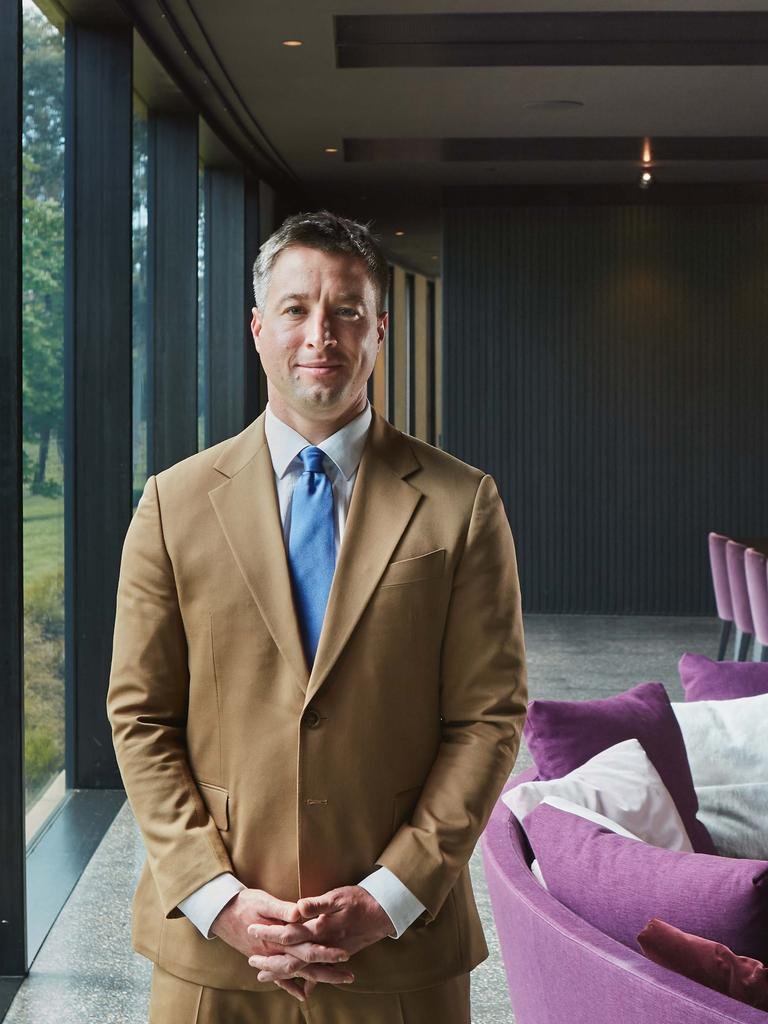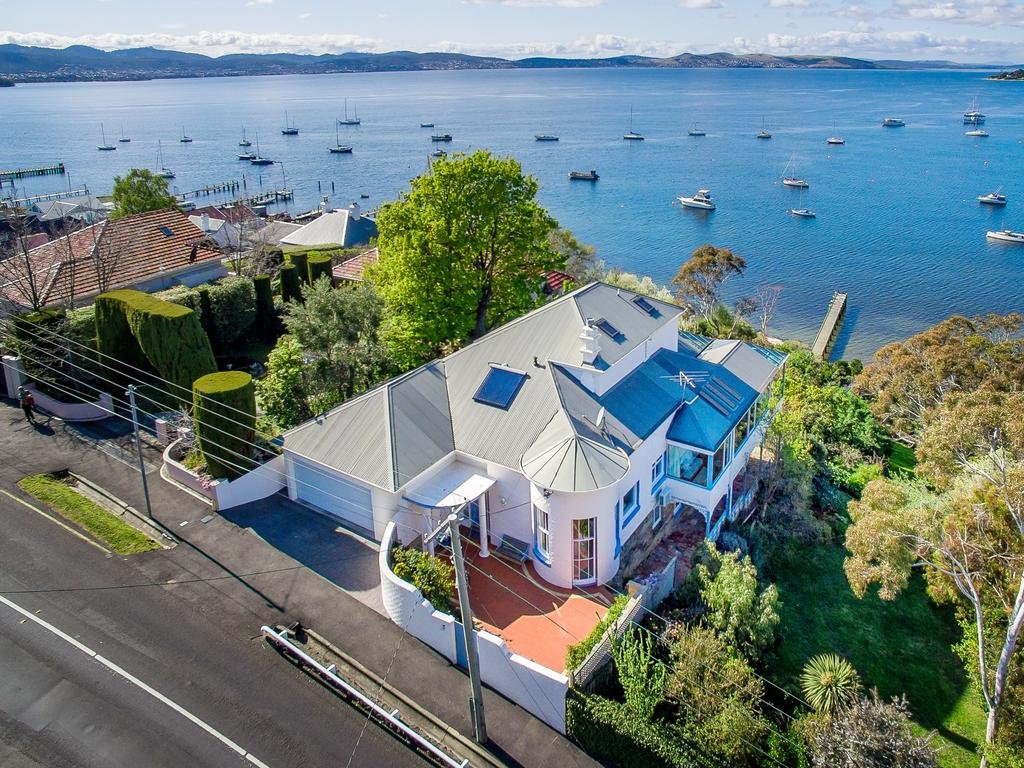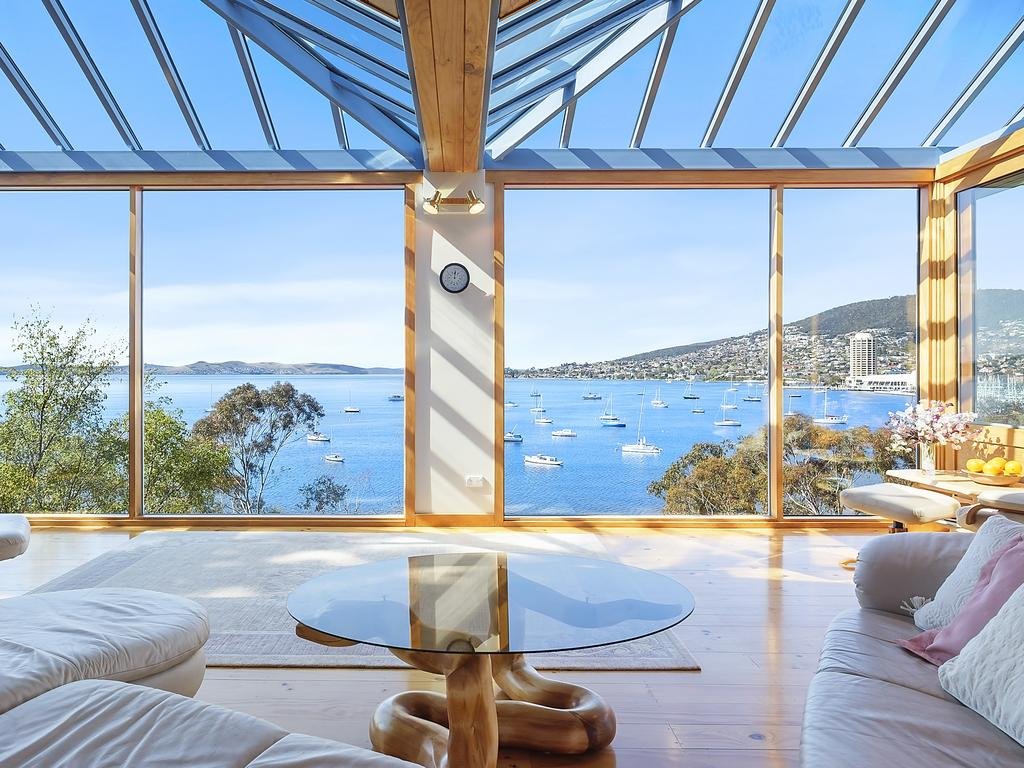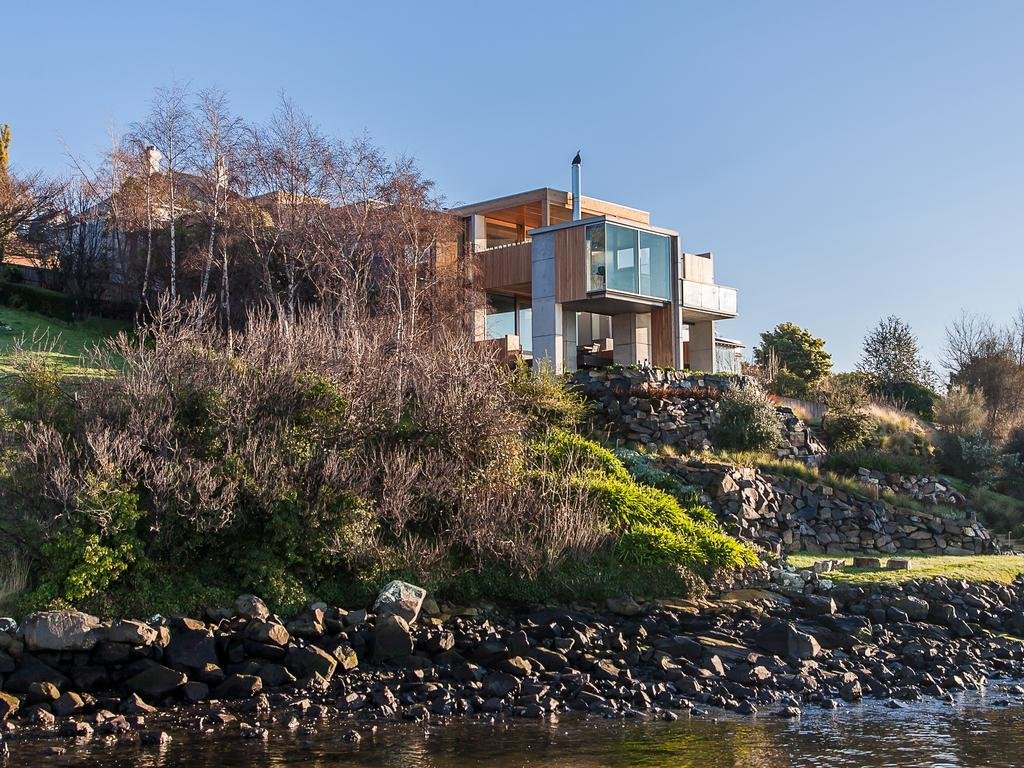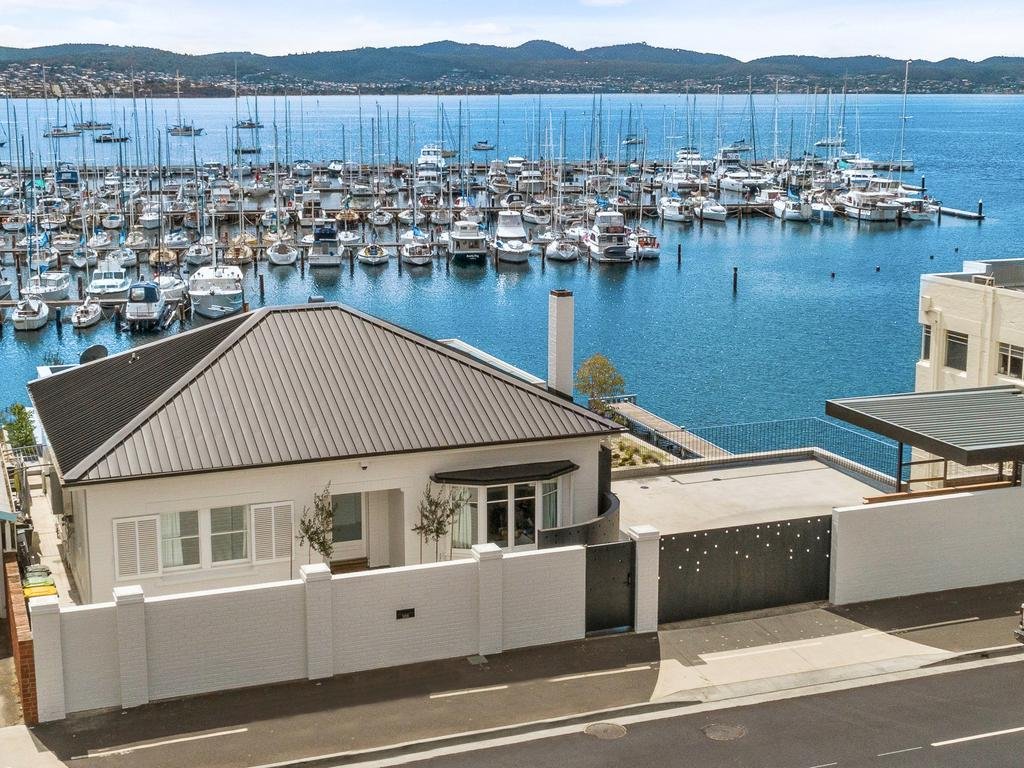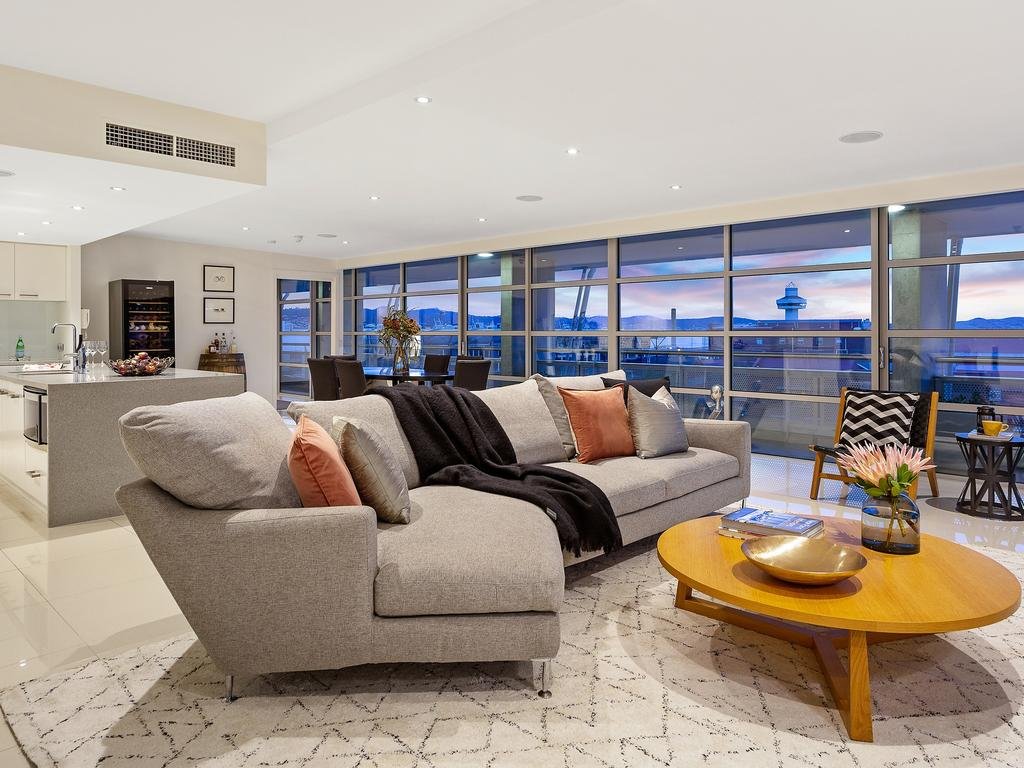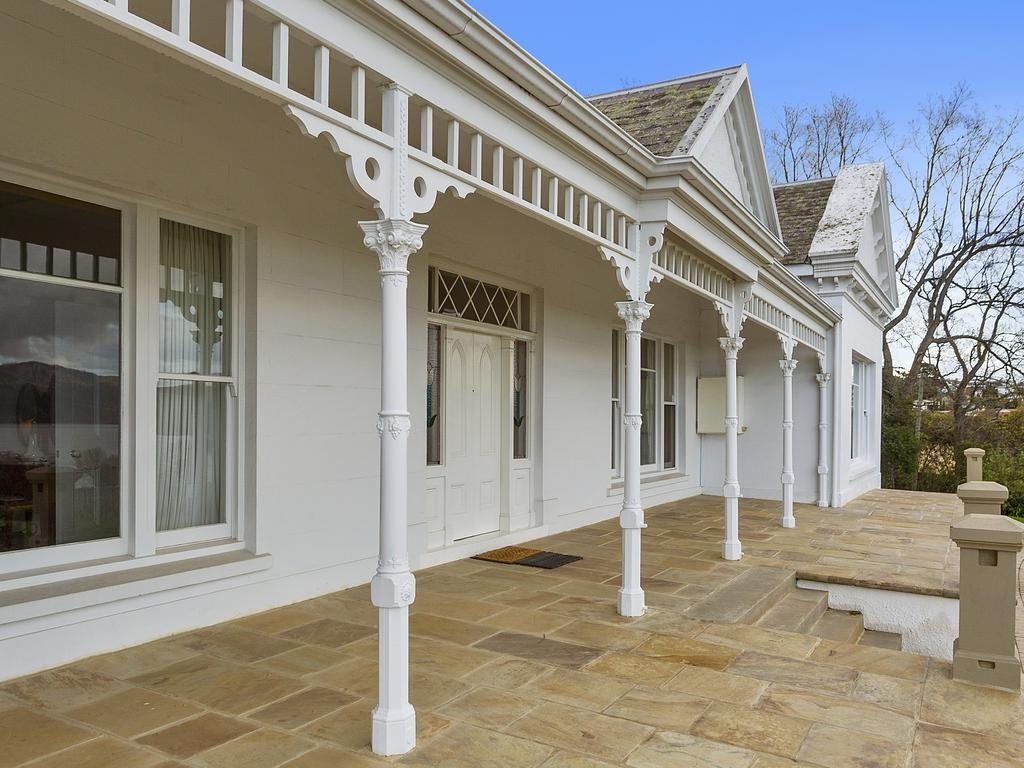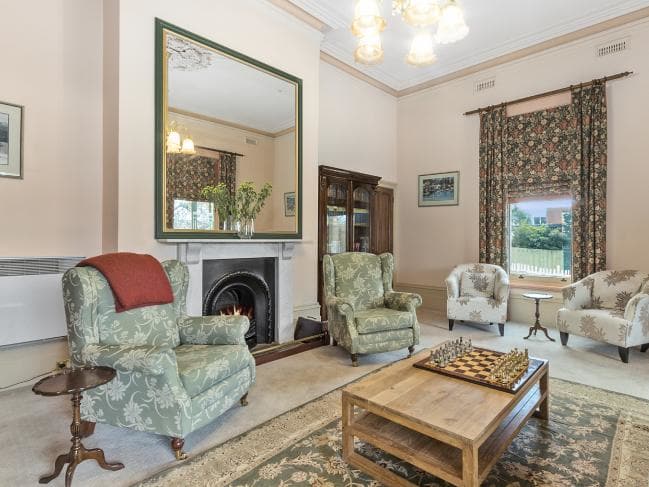Historic Vernon is Tasmania’s finest home for sale
Jarrad Bevan, Property Journalist | First published 19 Mar 2025, 5:00am | News Corp Australia Network
There is nothing quite like Battery Point’s 1870s-built Vernon.
Distinguished, luxurious, architecturally and historically significant — it is a property that has long been admired for good reason.
St Andrews Estate Agents director Steve Yannarakis said Vernon is among Tasmania’s very finest properties.
It is a special property that is impeccably presented and always grabs people’s attention when it comes to the market, he said.
“Since we launched, the level of inquiry has been strong. This includes locals and people from interstate, from Queensland, Western Australia and New South Wales in particular,” Mr Yannarakis said.
“For people that love stately, historically significant homes, Vernon is right there at the top of the wish list for many.
“It’s akin to something you might find in the country, with its parklike grounds and sprawling multi-level home.
“It’s extraordinary to think that Vernon is located within one of our most densely populated suburbs.
“Vernon is private, north-facing, and it has the most expansive lawns and gorgeous gardens.
“And then the interior of the home, that is something to behold — spacious, opulent, ornate, and quite the opposite of Battery Point’s commonly smaller homes and historic cottages.
“Vernon benefits from a high-calibre refurbishment that left no stone unturned in creating a beautiful modern lifestyle within its historic walls.
“While Vernon is a stately, sizeable property, it is also a comfortable family home — it is, truly, the best of both worlds.”
This grand residence is much admired for its towering gothic roofline, ornate gables, finials and spectacular grounds on one of the largest land holdings in Battery Point.
It is reminiscent of a country estate with its expansive lawns, magnificent trees, curved gravel driveway and superbly manicured established gardens.
This extraordinary sanctuary is like no other.
At the ground floor of the home, entry is through a stunning foyer, with the formal dining room, formal living room, lounge room, an eat-in kitchen all at hand.
This level is home to a study, bedroom, bathroom and a magnificent sunroom.
The upper level comprises a phenomenal master bedroom suite with a walk-in wardrobe and a marble ensuite.
There are three further double bedrooms and a family bathroom.
This magnificent home abounds in features that can take your breath away, including the grand staircase with blackwood timber handrails.
The high ceilings with ceiling roses and picture rails, and original fireplaces, speak to its 1800s era.
Hydronic heating is complemented by multiple wood heaters, to ensure comfort in Hobart’s coolest months.
Vernon’s superb kitchen has natural stone benchtops, a Smeg oven/cooktop and butler’s pantry, and bespoke joinery.
Sanded and polished timber flooring and high-quality light fittings and window furnishings add to the allure of this stunning home.
The property also features an abundance of off-street parking and enjoys the luxury of two vehicle access points. There is also a security system.
Vernon is within a short stroll of Hampden Rd village shops, cafes, restaurants, Shippies and the Prince of Wales hotels, Jackman & McRoss bakery, Salamanca Place, Sullivans Cove, the Mona Ferry Terminal, parks and the city centre. It’s an exceptional location, offering unrivalled amenity in a vibrant village setting, steps away from the best Hobart has to offer.
No.11 Mona St, Battery Point is for sale by expressions of interest, contact St Andrews Estate Agents for details.
https://www.realestate.com.au/news/historic-vernon-is-tasmanias-finest-home-for-sale/
Battery Point Circus home sold fast as lightning
Jarrad Bevan, Property Journalist | First published 4 Dec 2024, 5:00am | News Corp Australia Network
WHEN homes in Arthurs Circus hit the market, people waste no time putting their best foot forward.
There are only so many of them, and they rarely come to the market.
When No.47 Runnymede St, Battery Point launched last week, it only took a handful of days to find its new owner.
St Andrews Estate Agents director Steve Yannarakis said it was under offer within the week and has now been sold for an excellent, currently undisclosed price.
“There was a lot of interest, and ultimately it was secured quickly by a decisive purchaser,” he said.
“It sold very, very quickly.”
Mr Steve Yannarakis said Arthurs Circus is a Battery Point neighbourhood with a rich history, developed by Governor Arthur — a foundational governor who achieved a lot in Hobart.
“These properties are such a rare proposition. There’s not many in Australia that overlook a village green,” he said.
This Georgian cottage dates back to 1850, and has two bedrooms and a single bathroom within its 60sq m floorplan.
Its exquisite refurbishment was a big part of the appeal for buyers, Mr Yannarakis said.
The home incorporates polished timber flooring, Bosch kitchen appliances, built-in wardrobes, under-tile bathroom heating and freshly painted interiors.
Entry is into a cosy sitting room with an open fireplace.
There is a conjoined lounge room with polished floorboards, an open-plan sun-drenched kitchen-dining area, and a private, paved courtyard-style rear garden.
In some years, Battery Point will record just a dozen sales in 12 months, but right now buyers are flushed with choice.
Mr Yannarakis noted that there are over 30 properties currently on the market.
“I’ve never seen so many,” he said.
“With all of that choice available, it does speak to how special and sought-after No.47 was to sell so fast.
“For people looking to get a foot in the door of our most prestigious suburb, it would appear that now is a good time.
“As for why there are so many available, I think a big factor is that people of a certain age are ready to downsize, and they have come to market at the same time.
“Some mainlanders who have bought here might see it as time to sell.
“It might be cost-of-living pressures, perhaps a second house is less desirable than it was.
“There could be any number of reasons, but downsizing is a big one.”
With its heritage cottages curving around a central public green space, Arthurs Circus is certainly one of the most admired neighbourhoods in Tasmania.
Its allotments were first put on the market in 1847 by Lieutenant Governor George Arthur. The Circus became part of Runnymede St in the 1930s.
These cottages are not available to purchase often, with recent sales — per realestate.com.au — including No.36, which sold in 2022 for $1.05m; No.40 in 2021 for $1.18m; No.55 in 2020 for $1.65m; No.42 in 2016 for $680,000; and No.47 in 2014 for $632,5000.
Opulent mansion with JAWS garden conservatory for sale
Is Minallo the finest home on the market in Tasmania? One could certainly make that argument with ease.
Jarrad Bevan, Property Journalist | First published 24 Nov 2023, 5:00am | News Corp Australia Network
Is Minallo the finest home on the market in Tasmania? One could certainly make that argument with ease.
Built in 1891, and aptly described as an “opulent mansion in a grand garden setting”, few homes strike such a perfect balance between old world charm and character alongside exquisite contemporary living.
Listed for sale by St Andrews Estate Agents director Steve Yannarakis, the property has already caught the eye of buyers who are looking for a statement home.
Mr Yannarakis said the renovation, restoration and extension of the house by the current owners had been a “labour of love”.
“Minallo is an absolutely brilliant property, a peerless residence,” he said.
“It starts with the grand 19th Century house, and ends with a cutting-edge, sophisticated extension by award-winning firm Jaws Architecture.
“You rarely see this type of design and construction executed to such a high level.
“It’s the type of stately property that is easy to imagine among the mansions of Toorak, in Melbourne.”
Alongside the impressive four-bedroom house, Mr Yannarakis noted the location on 1726sq m of land as enviable.
“The position is a dream with glorious city and river views, on a level block, and just around the corner from popular Smolt Kitchen and The Hill St Grocer,” he said.
“It has inner-city convenience, but in a sprawling private garden setting.
“As you travel along the driveway, you feel like you are approaching a majestic country estate. And yet you are just five minutes from the city centre.
“As impressive as the grounds and the exterior of the house are, there is so much to discover inside, as well. Even the butler’s pantry would put most kitchens to shame.”
No.22A Pine St, West Hobart is the epitome of a refined lifestyle.
This distinguished home offers an abundance of formal and informal living spaces that make the most of its captivating garden setting.
Included within are four large, double bedrooms — including a master with an ensuite — alongside a study, a family bathroom, powder room, and a stunning formal entry foyer that features original tessellated tile flooring.
The interlinked living spaces comprise a formal lounge, an informal living room, and a state-of-the-art kitchen with a butler’s pantry featuring custom spotted gum joinery.
Step through to the stunning glass pavilion and prepare to be wowed. There is limestone flooring and floor-to-ceiling glazing in this dramatic double-height conservatory.
Via pivot doors, this indoor-outdoor room opens fully to a large deck. The outdoor living area boasts a pond, lawn and delightful established gardens.
The house features an impressive roll call of appointments and features, including a private driveway with an automatic gate, stunning bay windows, soaring ceilings with ceiling roses and period detailing.
There is hydronic heating, bespoke timber joinery, chandeliers, Cole & Son wallpaper, double glazed French doors, Dekton and marble finishes, European appliances — including three integrated refrigerators-freezers — V-Zug ovens, two integrated dishwashers, a zoned Hunter watering system, and built-in B&W and Bose speakers.
The property features an abundance of off-street parking behind the secure gates.
Mr Yannarakis said Minallo sets the standard for distinguished period architecture blended with cutting-edge design within a sublime garden setting.
“West Hobart is among our most sought-after inner suburbs — offering exceptional amenity, being within walking distance of local cafes and North Hobart shops — and Minallo is the suburb’s finest home on the market.”
No.22A Pine St, West Hobart will be sold via expressions of interest. Contact St Andrews for details.
‘Line of buyers’: Clarke Ave home sold for multimillion dollar sum
They don’t come along every day — or year — but when they do they make a splash.
Sold: No.32 Clarke Ave, Battery Point. Picture: Supplied
Jarrad Bevan, Property Journalist | First published 9 Jun 2023, 6:00am | News Corp Australia Network
They don’t come along every day — or year — but when they do they make a splash.
No.32 Clark Ave, Battery Point has been sold in the mid-$2m range, the first sale in this coveted waterside location since May last year.
With only about 15 homes on the water side of the road, buying opportunities in this enclave are uncommon.
Property records show the most recent Clarke sales were at No.20, which fetched $5.45m in 2022; No.14 sold for $5.1m in 2021; and No.24 transacted at $4.55m in 2018.
No.32 Clarke Ave, Battery Point.
No.32 Clarke Ave, Battery Point.
St Andrews Estate Agents director Steve Yannarakis described Clarke Ave as one of Tasmania’s most desirable and exclusive neighbourhoods.
“Clarke Ave, Napoleon St, and parts of Sandy Bay Rd would be right up there with our most expensive areas, where beautiful homes fetch multimillion dollar prices,” he said.
“Waterfront in Clarke Ave is an area that is perennially attractive. There are always buyers for these homes, even in quiet markets.
“It is a rarefied atmosphere. To try to purchase something along the Clarke or Napoleon waterfront … it just doesn’t happen very often. There is a scarcity.
“And when something does hit the market, you tend to have a line of buyers for it.
“Some of these properties are held by a family across multiple generations.”
No.32 Clarke Ave, Battery Point.
No.32 Clarke Ave, Battery Point.
While certainly a beautiful home in a beautiful location, Mr Yannarakis said selling No.32 Clark was not without its challenges.
He said some potential buyers saw it as needing an extensive renovation.
“It is a home with an amazing story; only a handful of people have owned it since it was built in the 1800s, including a Tasmanian Premier, and the most recent owner who held it for six decades,” Mr Yannarakis said.
“Over the years, it has been a home of dignitaries.
Super agents: nation’s property elite
Our round-up includes those agents who have topped the sales around Australia this year and in years past.
From Property | November 15, 2019 | By JONATHAN CHANCELLOR
Our round-up includes those agents who have topped the sales around Australia this year and in years past.
BILL MALOUF
Bill Malouf has carved out his career in real estate after working in the family hotel business in Sydney’s western suburbs for two decades. “I asked for a desk at LJ Hooker and if I did not prove myself in six months they didn’t have to pay me,” he recalls. “I’m still here!” Malouf has been their top national sales person 19 times since the mid-1980s and in 2006 entered the LJ Hooker Hall of Fame.
He says he’s been challenged in the current market by the unethical practices of some rival estate agents intent on securing their listings. “I do strongly believe that our industry needs to be cleaned up,” he says. “I’m finding that agents are so desperate for the business they are giving vendors unrealistic expectations. I don’t believe we are viewed by a lot of other professions as credible and honest people.”
Availability of stock in the eastern suburbs has dropped by around 45 per cent compared to two years ago, says Malouf, who is the top seller in Sydney this year.
In conjunction with Christie’s International agent Ken Jacobs, he secured the off-market sale of the Point Piper waterfront of Westpac board member Steve Harker, for around $40 million, to the start-up investor Alexandra Jakob and her entrepreneur partner Gabriel Jakob. He also had a hand in the recent sale of the heritage sandstone mansion Bomera, on the Potts Point clifftop. It reportedly fetched around $34 million when bought by the steel baron Sanjeev Gupta, who will soon vacate his Bellevue Hill rental, Barford. Malouf sold it, along with agent Clint Ballard, for Leanne Catelan, the daughter of the late RP Data founder Ray Catelan, who paid $12.5 million for it six years ago.
Malouf has a passion for the water – “Any free time I may get throughout the year I love to spend on or close to the water,” he says – and his greatest successes in real estate have been on the harbour. In 2007 he secured the national price record for a single home with Routala, a harbourfront home at Point Piper sold for $29 million to Rubicon founder Gordon Fell and wife Philippa. The year before, he and then colleague Brad Pillinger sold the “Bang and Olufsen” house nearby to the McWilliam family for $24 million.
Malouf now works with his son, David. “We clash,” he says, “but we also bounce off each other.”
BRAD PILLINGER
Brad Pillinger’s only career has been in real estate. He started in residential at Double Bay in 1995, having been at Gilmour Commercial at Parramatta for the previous five years.
“My parents were insistent I get a start without any of my dad’s influence,” the son of the late industry doyen Ron Pillinger recalls. “I was inspired into this industry.”
His highest sale came in 2017 when Portofino in Point Piper fetched $60.66 million for the car dealer, Neville “Croaky” Crichton. “It took a year to do,” says Pillinger. “It was great fun as the property is amazing. The vendor and purchaser were such entertaining personalities.” He relished working with the conjunctional agent Bart Doff.
Since then he’s sold another in Point Piper for $50 million-plus for the Fell family. His first waterfront for $8.25 million came in 2000. “The buyer was offered $65 million last year,” he says.
Pillinger recalls that he and his father talked endlessly about how to improve at sport, academic pursuits and how to execute difficult sales. “The thrill of the sale is always fantastic regardless of price point and regardless of how many times I do it.”
WILLIAM PORTEOUS
William Porteous, Perth’s biggest name in real estate for four decades, worries that the computerisation of the sales process presents the biggest challenge to the art of salesmanship.
“No one ever sits down and eyeballs anyone anymore – it’s all email and text messages,” he laments. But he loves the globalisation of the market, and being able to contact anyone instantly wherever they are in the world.
He began his journey in real estate in 1971, working for Alan Bond at Bond Corporation. “Even though I was not employed as a salesman, I went into a 100-unit development and sold three properties on my first day,” he says.
This year he secured WA’s biggest sale – a family estate on Mosman Park’s Chidley Way that fetched $12.05 million. He sold the house next door two years ago for $21.5 million.
Porteous has regularly held state, and national, house price records. In 2009 he sold a Mosman Park compound for a then record $57.5 million. The Swan River’s mansion mania saw Porteous hold another Australian record too. It was a home on Jutland Parade, Dalkeith, sold in 1980 for $4 million to the mining speculator Danny Hill.
VIVIEN YAP
Perth agent Vivien Yap is the number-one female principal selling agent in the Ray White network, as she nears $1 billion worth of property over her still short career – she only moved into real estate in 2012.
Her biggest sale came last year, when she sold a block of land on the Swan River for $17 million. The 6580sq m Oswal family holding was once home to the never completed mansion dubbed Taj on Swan. “It had been languishing on the market for more than a year due to all the negative press,” she says. “For me, it was a massive sense of pure relief mixed with excitement that I finally did it.”
Yap had to deal with local as well as international buyers, as well as vendors’ representatives in Dubai, India, US and Sydney.
She joined Ray White in 2017, having been at LJ Hooker, where she had been recognised as its top-selling principal, the first time the award went to a woman. She had spent more than 20 years in the pharmaceutical industry.
“I saved money from my first pay packet to buy my first property,” she says. “I have always believed in property as an asset class.”
BEN COLLIER
Ben Collier, one of the founders of The Agency, specialises in prestige real estate in Sydney’s eastern suburbs. He has secured records across many suburbs, including Centennial Park, Bellevue Hill, Paddington and Woollahra. “I never take for granted that I’ll obtain a listing, nor do I take for granted securing a sale,” he says.
Collier arrived in Sydney in the early 1990s from Grafton and real estate is virtually all he knows. “I knew I wanted to enter real estate in the Paddington and Woollahra markets, and so I spent four weeks researching who were the four most proactive agents in the area,” he recalls. The leading McGrath Partners agent James Dack was one of those four. “I called him every day for weeks.” Collier was offered work experience and became a sales assistant two years later. The biggest sale of his career came last year, in conjunction with veteran agent Bart Doff, when the trophy home Rona in Bellevue Hill sold to the Scheinberg family for $58.3 million. Late last year Collier sold a Coolong Road, Vaucluse, property for $38.8 million and this year he secured the sale of a Tivoli Avenue home in Rose Bay for $23.5 million.
STEVE YANNARAKIS
Tasmanian agent Steve Yannarakis, who heads St Andrews Estate Agents Hobart, believes one of the best preparations for real estate was training as a property valuer. “This is an incredible grounding,” he says. “I am still amazed at how many agents have little to no idea of how property ownership works.”
He says if he could change one thing about the industry, it would be to have higher education and training standards for agents. “Better-informed agents have better credibility with sellers and buyers alike,” he says. “Training in ethics, property law, valuation methods and demographic trends.”
Yannarakis secured Tassie’s biggest sale in the past 12 months, selling a Battery Point home on the Hobart riverfront, for $4.4 million. He says it was a once-in-a lifetime opportunity to acquire one of Hobart’s most significant residential properties. Set on a 1175sq m Derwent River block, the home dates from 1896, with an extension added in the mid-1990s. “Not a big price by Point Piper or Toorak standards, but by Tasmanian standards, where recent price growth has been impressive,” Yannarakis says.
RICHARD AND SOPHIE LUTON
Richard Luton founded his own real estate company in Canberra two decades ago, partly out of uncertainty about his three daughters gaining employment.
Now daughter Sophie is his colleague, and the pair hold the mantle for securing the highest house price in the ACT in the past 12 months – a $4.5 million sale in Forrest. In 2017 they set the house price record in Deakin, selling a Terry Ring-designed home for $5.75 million and topping the previous suburb high by $1.45 million.
Richard, who grew up on a farm in the Snowy Mountains region, says it’s not an easy job but it is a very rewarding one, both morally and financially. “Getting to know so many people, assist them moving into their next stages of life and creating lifelong clients and friends is an amazing combination,” he says.
He says he combines old-school approaches with innovation. “There will always be the importance of the simple old ways –communication, negotiation skills and empathy – but you need to be able to incorporate change into your style and business with an ever-changing industry.”
KEN JACOBS
Ken Jacobs is arguably Australia’s leading prestige agent, with consecutive national house price records to his name. He says he’s working on the next. The Christie’s International principal has secured the past three top sale prices in Sydney: the $70 million sale of the Vaucluse home La Mer, on behalf of casino tycoon James Packer and his then wife, Erica, in 2015; the $71 million record sale of Double Bay’s Elaine to Atlassian billionaire Scott Farquhar, in 2017; and the neighbouring Fairwater to Farquhar’s business partner Mike Cannon-Brookes a year later for $100 million.
His sales include taking prices through the $20 million barrier when Boomerang, a Spanish Mission home on Sydney Harbour at Elizabeth Bay, was sold in 2002 for $20.7 million.
“Prior to real estate I was licensed with the NSW Health Department as an optical dispenser but, excuse the pun, I couldn’t see it as my future,” he says. “Real estate offered a diversity that intrigued me.” He says the industry has evolved but it’s still “fundamentally about people, not property. People and what motivates them have not changed.”
MATT LANCASHIRE
Brisbane agent Matt Lancashire holds the Brisbane house price record. In 2016 he sold the city’s most expensive property, at Kangaroo Point, for $18.48 million. This topped his earlier sale, when Balaam in Hamilton was sold for $11.8 million in 2015.
“Nothing beats selling a property for a client for a record price,” the principal of Ray White New Farm says, adding that the new world of technology has been a “game changer”.
Lancashire’s love of real estate includes building a few houses himself, the most recent in Teneriffe, where he gained national coverage for his “Bat cave” style gym. He moved into real estate in 2006, landing his first job with agent cum auctioneer Haesley Cush, and believes his apprenticeship as an electrician helps gives him an edge. “I have a thorough understanding of how construction works,” he says.
There’s only one thing he would change about real estate, he says: how easily agent licences can be obtained. “I believe they give away licences way too easily,” he says. “I think they should regulate who comes into the industry. Real estate agents have that bad name because there are cowboys in the market.”
SARAH HACKETT
Brisbane estate agent Sarah Hackett recently secured Brisbane’s highest price for a house sold at auction, and the top sale of the year. The Bulimba riverfront went for $8.4 million.
“It was a beautiful family home on a large parcel of land on the riverfront,” Hackett says of the five-bedroom residence.
The Place Bulimba managing director says the best feeling is when she secures a great listing. “That is really the hardest part,” she says. “A beautiful home in a great position will have a lot of interest from prospective purchasers, so when the sale eventuates it’s kind of a pat on the back for the process but the exhilaration is when you first get appointed.”
Hackett sold her first property working as a receptionist at a real estate office more than two decades ago. She dropped out of university where she was studying science before her real estate career took off. “A number-one LJ Hooker agent suggested I try real estate and said she believed I would be excellent at it,” she says.
Her highest apartment sale came in 2016, when she sold in the city for $8 million. The data shows it sold to Kevin Rudd and Therese Rein.
SEAN CUSSELL
Professionalism and negotiation skills are what set the good agents apart, especially in a tough market. That’s the view of Christie’s International, Prestige Homes of Victoria principal Sean Cussell.
Recently Cussell has been credited with two of Melbourne’s highest ever sales, a record-setting off-the-plan deal, plus the off-market sale of Melbourne’s priciest residence. “Both of these sales are confidential,” he says. “They were created from matching private clients, off market, through my private client register.”
He is credited with securing Melbourne’s highest sale in the past 12 months, the $30 million off-the-plan penthouse in the yet to be built St Moritz complex in St Kilda, to the former Domain boss Antony Catalano.
Stonington, the Malvern mansion of art dealer Rod Menzies, sold to Chinese interests for a Victorian house price record of $52.5 million, with the local press giving credit to Cussell and the Kay & Burton agent Michael Gibson.
The 1890s home, built by Cobb & Co partner John Wagner, bettered the previous $39 million record for a Toorak sale in 2017.
ALISON COOPES
Sydney agent Alison Coopes, who runs her own agency, Agency by Alison Coopes, wears the mantle for the highest house price sale by a woman in real estate. She has sold the Point Piper trophy home Altona twice – first for $52 million in 2013, then again three years later for $61.8 million, both times in conjunction with listing colleagues. She also secured the highest sale in 2016, a $47.8 million Carrara Road, Vaucluse harbourfront.
Coopes was working in recruitment in the mid-’80s when the Richard Ellis agency engaged her to find someone capable of marketing the Quay, the first off-plan Sydney CBD high rise to be marketed. “After I presented candidates they approached me to ask if I would take on the role instead,” she recalls.
She went on to work in Double Bay, for Laing and Simmons, LJ Hooker and Ray White.
Coopes says the biggest change she has seen in the real estate industry is that sales are now all about the agent, not the agency: “It is very personalised and the owners look long and hard at your track record and performance.
GRANT GIORDANO
South Australia Sotheby’s principal Grant Giordano said that the thrill of the sale once motivated him, but now there’s more to it. “As you grow in the industry, the adrenaline rush is replaced more by feelings of relief or empathy on behalf of your vendor,” he says. “Securing their financial future is extremely gratifying.”
Giordano recently secured Adelaide’s third-highest house sale, at more than $6 million. There was also a seven-bedroom beachfront mansion in Tennyson that he sold for $5.2 million.
His biggest sale in the past 12 months, however, was in Switzerland, when he sold a home on a lake in Versoix for nearly $10 million.
After gaining some property experience in the US, he moved to Australia. “I wanted to apply what I’d learned in exclusive Toorak,”
he says. After sales totalling $50 million in 18 months, he relocated to head up the Sotheby’s Adelaide office. His latest prestige listing is a 2013-built Heathfield home in the Adelaide Hills designed by Woods Bagot, that won the South Australia Institute of Architects best New Home category in 2018.
It takes a few million to buy a home in the top end of Hobart
Some truly outstanding Hobart homes have sold and settled in 2019 — take a peek at the Top 5.
Battery Point dream home at 68 Napoleon Street. Picture: SUPPLIED
Some truly outstanding Hobart homes have sold and settled in 2019 — take a peek at the Top 5.
JARRAD BEVAN | 2 min read | August 21, 2019 - 12:00AM | Mercury
To get a foot in the door at the very tippy top of Hobart’s property market, about $3 million to $4 million-plus is what you will need.
When it settles in about one week, No.68 Napoleon Street in Battery Poi nt will be Tasmania's most expensive home sale of the year.
This grand five-bedroom 1890s residence is set on a 1174sqm waterfront block.
When it hit the market its price guide was in the $4 million-plus range.
St Andrews Estate Agents director Steve Yannarakis said the home had captured people’s imaginations.
He said it was crystal clear why the property was among the most viewed homes in the country.
Picture perfect.
A rare private Battery Point jetty.
“I would say this home has the best views that I have ever seen,” he said.
“It has water views from everywhere in the home and they are truly amazing, they will take your breath away.
“They span out wide, over 180 degrees, encompassing Mount Wellington, the Royal Yacht Club, Mount Nelson, Sandy Bay and Nutgrove Beach, right across to the Eastern Shore and down the river.”
There are less than 30 waterfront homes in Battery Point, which is Tasmania’s most exclusive and expensive suburb.
There are just six — including this one — that boast their own jetty.
Steve said being right on the water in Tasmania’s premier suburb was a luxury few properties could boast.
“This home ticks a lot of boxes, from its classical design to the enviable location,” he said.
Properties at this end of the market are a rare find.
“At the very top end of our market, homes like this are so thinly traded,” Steve said.
62 Napoleon Street, grand is every way.
The next largest sale of the year so far is a stunning home that requires little introduction, the Grand Designs Australia showpiece at 62 Napoleon Street, Battery Point. It was sold for more than $4 million.
This cutting-edge masterpiece dream home by Maria Gigney Architects is known for its unmatched quality and design that combined a charming 1890s weatherboard cottage with a striking, industrial, modern waterfront addition.
Breathtaking location.
In keeping with the theme of the top two homes, No.358 Sandy Bay Road combines contemporary design with classic architecture — in this case from the 1920s — and an enviable water’s-edge position.
The view from the kitchen and front deck of the yachts bobbing in the bay is a property lover’s dream come true.
Stylish and sophisticated, it should come as little surprise that this premium property was sold within two weeks of it hitting the market.
Rounding out the top five is a Hobart waterfront penthouse apartment and a historic homestead at Berriedale, which both sold for about $3 million.
Hunter Street penthouse.
The penthouse — owned by Australian cricketer James Faulkner — sits at the top of Zero Davey boasting spectacular views of Constitution Dock, the IXL Jam Factory, Macq 01 and the city and mountain.
It fetched $3.301 million.
The 1850-built Lowestoft overlooks the Moorilla vineyard and winery.
Absolute luxury.
On 3ha of land, the property boasts River Derwent, Mount Direction and Mona views.
This prime example of Regency architecture is a showcase of symmetry and elegance.
TOP END OF TOWN
Tasmania’s biggest sales for 2019
68 Napoleon St, Battery Point TBC (St Andrews Estate Agents)
62 Napoleon St, Battery Point $4.15 million (Knight Frank)
358 Sandy Bay Rd, Sandy Bay $3.7m (St Andrews Estate Agents)
31/15 Hunter St, Hobart $3.301m (Knight Frank)
680 Main Rd, Berriedale $3m (Knight Frank)
Source: realestate.com.au and CoreLogic
Hobart’s Battery Point is Best Enjoyed on Foot
Aerial View of downtown Hobart, Tasmania
POSNOV / GETTY IMAGES
The neighborhood in Australia’s island state of Tasmania boasts historic architecture and upscale shopping
BY MICHELLE SINGER | ORIGINALLY PUBLISHED ON MAY 25, 2019 | MANSION GLOBAL
On the fringes of Hobart's center, lined to the north by the historic Salamanca Place, Battery Point is the city’s oldest and arguably one of its prettiest suburbs; a palpable sense of colonial history assuaged by cute cottages and chic cafés.
Battery Point’s photogenic and sometimes awkwardly narrow streetscape is lined with weatherboard houses and sandstone cottages, beautified by house-proud owners, which regularly causes passing pedestrians to linger and capture that Insta-worthy photo.
Dating back to the first European settlement of Hobart, Battery Point holds a special place in the heart of locals and visitors alike. Its history is on display, with the British influence seen in the street names honoring several famous English heroes, including Wellington, Trafalgar, Nelson, or famous events in military history—such as Napoleon Street and Salamanca Place.
Its streets and village atmosphere is best enjoyed on foot, taking in the historic architecture along with boutique retailers, high-end hotels and artisanal cafes and restaurants that provide much of the area’s fashionable credentials.
Set on a promontory extending out into the River Derwent from Hobart's Constitution Dock, Battery Point was named after the battery of guns that were established in the area as part of Hobart’s coastal defenses in 1818.
The battery was built on the site of where Princes Park is set, on the northeast boundary of the suburb. The guns fired salutes for ceremonial occasions but were never required for an invasion. The battery was decommissioned in the late 1800s after a review of the site found its prominent location would draw enemy fire toward the surrounding residential neighborhood.
It has grown to become the city's premier address with historic buildings that date back to the first European settlement of “Hobart Town,” corner pubs and quiet winding streets.
Boundaries
Battery Point is a 15-minute walk from Hobart's center and is immediately south of the city. Access to the area can be made on foot from Salamanca Place up Montpelier Retreat, or Kelly's Steps, a sign-posted and historic point of access from behind the waterfront sandstone façade.
By car Battery Point is accessible via Hampden Road, the suburb’s main artery that runs off Sandy Bay Road from the edge of the city.
Bounded by Hobart’s renowned Saturday-held Salamanca Markets and the city’s historic heartland of Salamanca Place to the north, more than a quarter of Battery Point’s boundary, predominantly to the east, is waterfront.
The north-east facing Castray Esplanade, Clarke Avenue and Napoleon Street all enjoy waterfront aspects with the CSIRO, parks and prestige housing occupying sites immediately fronting the River Derwent.
Part of Quayle Street, Bath and St Georges Terrace separate Battery Point’s southern boundary with that of the neighboring suburb of Sandy Bay. The suburb’s western border takes in Albuera Street, Ellerslie Road and Gladstone Street, hugging the historic area of Hobart’s central business district.
Price Range
Tightly held houses and few new developments has cemented Battery Point’s position as one of Hobart’s most expensive residential suburbs.
In the 12 months to February, the median house price for Battery Point was A$1,003,000 (US$694,603) having increased in value 18.59% on the previous year, based on analysis provided by CoreLogic RPData.
During a time when the rest of Australia’s residential real estate markets softened, Sydney and Melbourne house values fell 10.9% and 9.8% respectively in the 12 months to the end of March—making Battery Point’s double-digit performance even more impressive.
However the property party is over, according to the area’s leading agent, Steve Yannarakis from St. Andrews Estate Agents.
In May he’s sold half a dozen houses and apartments in Battery Point, some on market, others found buyers without the need for elaborate marketing campaigns.
Interest is still strong, prices are holding up, however the number of enquiries being made are roughly half of what he was receiving 12 months ago, Mr. Yannarakis estimated.
“The party is over in terms of the growth, it’s stabilized and we’re going into a more steady, more traditional market,” he says, following Tasmania’s recent three years of accelerated, and unsustainable, rate of growth.
“The number of listings compared to a year ago has probably doubled. Having said that, there are a few properties that have been for sale for quite a bit of time, and that would be due to pricing or property issues.”
To get into Battery Point, buyers will need a minimum of A$700,000, Salamanca Realty principal Mark Lawler said, and that’s for a one-bedroom cottage or apartment.
It’s an attractive price point and option for investors, who continue to eye Battery Point with keen interest.
Three-bedroom houses and two-bedroom apartments with parking, cost anywhere between A$1 million and A$2 million, often more, depending on location, outlook and condition, Mr. Lawler said, having sold a premium two-bedroom apartment in the Silos building for more than A$2 million in early 2019.
History, proximity to amenities and access to the city and neighboring prestige suburb Sandy Bay—including the Royal Yacht Club of Tasmania—underpins Battery Point’s appeal and prices.
The suburb’s long-held A$3 million record—set in 2004—was finally broken in March this year with the A$4.7 million sale of a renovated waterfront property on Napoleon Street, through selling agent Mr. Yannarakis.
Buyer interest in the property was “overwhelming” Mr.Yannarakis said, especially as it came with a highly sought-after private jetty, boat shed and slip.
“There is still a value proposition in Tasmania relative to the mainland capitals,” he said.
“There are only 29 properties on Clark Avenue and Napoleon Street,” Mr. Yannarakis added. “They’re a finite resource and the most premium real estate you can buy in Tasmania. A property of this caliber in Sydney would cost 10 times as much.”
Battery Point Historic District, Hobart, Tasmania Island, Australia
Richard Cummins / Getty Images
Housing Stock
Battery Point has an attractive and eclectic mix of weatherboard and brick-row houses and a smattering of apartment towers.
There are commercial premises, such as the historic five-star Lenna Hotel, boutique retailers, cafes and restaurants along the village-like main thoroughfare Hampden Road. Australian marine and environmental scientists conduct research from the Commonwealth Scientific and Industrial Research Organisation (CSIRO) Marine and Atmospheric Research centre, which features a deep-water port for access to the Southern Ocean, from the waterfront at Castray Esplanade.
Its most prestigious holdings are the large and extravagant homes tightly held on the waterfront of Clarke Avenue and Napoleon Street. There are only 29 waterfront blocks in total, and of those only a handful have private moorings, a jetty or boat shed, onto the River Derwent. Residents here experience some of the best views in the state with uninterrupted vistas northeast up the river, direct water access and year-round sun exposure.
Luxury Amenities
There’s nothing a Battery Point resident wants for in terms of lifestyle.
A 10-minute walk into the central business district for those who are still working negates parking woes and traffic battles. Hampden Road serves not only as Battery Point's main artery but also as one of Hobart's finest café strips with historic luminaries Jackson & McRoss and restaurants such as the 25-year-old D’Angelos, a drawcard for locals and tourists alike.
But if waiting for a table isn’t your thing, it’s only a five-minute walk to Salamanca Place for access to myriad food and beverage options that satisfies cravings and thirsts regardless of time or day.
Artisanal produce, locally-distilled award-winning whisky, gin and wine are accessible within a few minutes’ walk and early risers can nip to the weekly Salamanca Markets for bread, flowers and seasonal veggies before visitors have time to ask “where do I park?” Hipster hangouts over beers and burgers happen in the atmospheric garden, or the old bus, at Preachers.
For those not wanting to leave the confines of their cozy suburban streets, there are dog-friendly parks, quiet historic corners, the striking St. George’s Anglican Church plus the annual Taste of Tasmania food festival and the finish line of the Sydney to Hobart yacht race at their front door.
Battery Point’s central location places it in the midst of Hobart’s best schools and educational facilities, all found within a five-kilometer radius. Among them are several primary schools for kindergarten-to-year-six students such as Albuera Street Primary School and Princes Street Primary School. Some of the state’s most highly regarded independent schools are in nearby Sandy Bay or Hobart, offering facilities for day students and borders alike, including Hutchins School for boys, Fahan School, St. Michael’s Collegiate and St. Mary’s College for girls and the co-ed Friends’ School. Senior secondary colleges for students in year 11 and 12 include Mount Carmel College and Hobart College, atop Mount Nelson. The University of Tasmania Sandy Bay campus is a 15-minute walk away.
Who Lives There
The last three Battery Point properties Hobart prestige agent Mr. Yannarakis sold, or showed potential purchasers through, attracted people in their 60s.
Some were from interstate looking to retire to Tasmania, others locally based buyers, but all were of retirement age, looking for the ultimate lifestyle opportunity.
“Most of the properties are going to baby boomers. We don’t sell to 20 or 30 year olds because they can’t afford it anymore,” he said.
“People are in their 60s. That’s the reality of it. They want to be close to everything, they appreciate the history of the suburb, the beautiful streetscape and the proximity to all the amenities.”
There’s just shy of 2,100 residents living in Battery Point, according to Australian Bureau of Statistics figures derived from the 2016 Census. The median weekly household income of A$1,376 is higher than the statewide median of A$1,100, and more than a quarter of residents are aged 55 or older.
It’s a trend Mr. Lawler is seeing, too, in the various prestigious apartment complexes in the suburb including Salamanca Square, Salamanca Mews and the Silos building that fronts the Hobart waterfront.
“These are all quite popular with retirees and people who are downsizing,” he said.
“The majority of these people are downsizing from substantial properties, some have come from the Australian mainland, and this area and buildings are highly sought after,” he said.
Notable Residents
Hollywood film actor Errol Flynn was born in Battery Point at the Queen Alexandra Hospital in 1909. Educated at several Hobart schools, Flynn left the island state for Sydney, aged 18, in 1927.
Today the suburb is occupied by business and art luminaries who prefer to keep a low profile and fly under the radar such as Melbourne-based developer theatre owner David Marriner, who keeps a waterfront home in the suburb, visiting from the mainland regularly.
Agents are tight-lipped on the suburb’s other high-profile residents, but have confirmed art collector, philanthropist and Museum of Old and New founder David Walsh and his wife, American artist and curator, Kirsha Kaechele, live in a luxurious Ellerslie Road townhouse.
Outlook
Hobart’s residential real estate market has been through three years of strong growth, Battery Point among its most sought-after and prestigious suburbs.
The area’s annualized 10.77% growth each year for the past three years, based on CoreLogic RPData figures, illustrates a sustained level of demand from locals, interstate migrants from mainland Australia and investors.
While there are indications that the intensity may have come off the market, with first quarter falls in values of about 5%, agents report continued interest and strong sales results for their sellers.
“Interest is always strong in Battery Point. It’s seen as one of the premium suburbs of Hobart, certainly one that everyone in Tasmania and Australia knows about,” Salamanca Realty’s Mr. Lawler said.
“Properties from apartments through to stand-alone houses are holding up very well,” he said. “They’re just taking a little longer to sell, which is consistent with the rest of the market.”
Tasmania: An Australian Island’s Stunning Rise
This three-level house on Napoleon Street in Battery Point sold for more than A$4 million in late October.
ST ANDREWS ESTATE AGENTS
A once-untouched paradise has become a luxury hot spot
BY MICHELLE SINGER | ORIGINALLY PUBLISHED ON MARCH 20, 2019 | MANSION GLOBAL
Jocelyn Boyd’s love affair with Tasmania—located on Australia’s south coast and affectionately known as the Apple Isle—stretches back more than a decade.
Like hundreds of tourists each year, Ms. Boyd, a health information-technology professional, once rented a motor home and embarked on the quintessential driving holiday along Tasmania’s heavenly eastern coastline and remote and isolated wild west.
She has hiked the famed Overland Track, watched the sunrise over Wineglass Bay in Freycinet National Park, and wined and dined at world-class restaurants, renowned for their use of sustainable seafood and homegrown produce.
"It has kind of been the untouched paradise that so many Australians have never been to," Ms. Boyd, 36, says. It’s little wonder that Ms. Boyd and her partner, builder and photographer Mitch Leeming, decided to buy a three-acre block on Tasmania’s Bruny Island, 45 minutes south of Hobart, the island state's capital.
Ms. Boyd and Mr. Leeming are part of Tasmania’s steadily increasing population, on the upswing since 2013 and last year rising faster than the national average. In 2018, the population hit more than 528,000.
It’s clear that the island, Australia’s smallest state, is attracting a vibrant mix of young families, hopeful couples, and adventurous retirees—all looking for a lifestyle that revolves around fresh air, artisanal produce, and community ties.
"It offers such an incredible lifestyle; it’s fresh and clean. You can be in a city but you’re only half an hour from remoteness," Ms. Boyd says.
Ms. Boyd and Mr. Leeming’s offer of 190,000 Australian dollars for the gently sloping property, with 180 degrees of uninterrupted water views across the D'Entrecasteaux Channel, was accepted within three days of the block hitting the market.
The iconic Italianate mansion Glenfruin in Launceston, which sold for A$3.25 million last year.
Knight Frank Tasmania
This, Ms. Boyd says with pride, is where they’ll build their dream home.
"It suits our lifestyle and where we are headed in the future," Ms. Boyd adds.
There’s also no denying the pulling power of the value proposition of Tasmania’s housing.
Until late 2018, Tasmania was Australia’s cheapest housing market, attracting many disillusioned home buyers who had become priced out of many Australian mainland cities. The population growth coincided with a turnaround in the island’s financial fortunes, resulting in the perfect economic storm.
Since 2013, Tasmania’s tourism industry, business investment, gross domestic product, employment levels, and population have all been steadily increasing, according to the state's Department of Treasury and Finance.
Tasmania’s unemployment level rose to 6% at the close of 2018, its highest level in 12 months but still significantly lower than the 7.4% it reached in 2014, according to the Australian Bureau of Statistics. The real estate market, too, has outperformed the rest of the country, with double-digit price growth each year since 2016.
Despite momentum easing in 2018, Hobart’s median house prices continued to outperform the rest of the country, increasing 8.7%, to A$490,000 in 2018, overtaking both Adelaide and Perth for the first time, according to CoreLogic RPData figures.
The iconic Italianate mansion Glenfruin in Launceston, which sold for A$3.25 million last year.
Knight Frank Tasmania
Housing demand, population growth, and economic prosperity have helped boost Hobart’s median house prices by more than 40% since 2016.
In 2018, A$4 billion in residential transactions changed hands in Tasmania, its highest level of activity in terms of number of sales as well as dollar value, according to the Real Estate Institute of Tasmania, or REIT.
Tony Collidge, president of REIT, says A$2 million is becoming the norm for the price of prestige real estate.
In the six months to June 2018, there were 89 million-dollar-plus sales recorded. For all of 2017, a record 120 million-dollar-plus properties sold. And there were several multimillion-dollar sales in the second half of 2018, including the iconic Italianate mansion Glenfruin, on Brisbane Street in Launceston, which sold for A$3.25 million.
A three-level house on Napoleon Street in Battery Point sold for more than A$4 million in late October. It was the most popular online listing in Australia, according to realestate.com.au figures, attracting significant local and interstate interest, says St Andrews Estate Agents property consultant Steve Yannarakis.
"There’s demand and depth in the market and around the inner suburbs of Hobart. People are attracted to the lifestyle you can have here," Mr. Yannarakis says. "It’s casual and friendly, there's great restaurant food, as well as culture, vineyards, and cafes."
"The extension of the Hobart International Airport will be a game changer," Mr. Yannarakis says. "All of a sudden, Tasmania is cool and fashionable."
Sparkling waterways and lush fairways surround these exceptional new homes
ALL of the waterfront homes to be built at the Claremont Golf Club have been sold.
St Andrews Estate Agents director Steve Yannarakis said demand for the North Shore residential development properties had been “exceptional”.
“So far we have sold 26 homes, with a value over $10 million,” he said.
“Every waterfront residence from stages one, two and three has been sold.
“[Construction company] Vos is now building stages two and three.
“When complete there will be about 50 homes.”
Steve said practically everyone who had bought at North Shore was a downsizer.
He said so far there had been only three investors who had bought property at North Shore
“I would say the vast majority of buyers have a golfing interest,” Steve said.
“When viewing the homes people have been impressed with the outlook — water on one side and the greens on the other — as well as the high quality of the build, which is tight as a drum.
“I was confident that North Shore would sell well, and as soon as the first home was built the sales started to fly.”
These architecturally designed homes have a lush feel with their high, raked ceilings coupled with large windows, plush carpets and chic kitchens and bathrooms.
While the waterside homes are long gone, St Andrews is selling two- or
three-bedroom townhouses located directly beside the waterfront properties.
The fit-out is identical, albeit with an adjusted floor plan to suit a two-level home.
That extra height allows water views across the top of the neighbouring homes towards Old Beach.
And on the other side of the townhouses there are also uninterrupted golf course and Mount Wellington views.
There are options available such as upgrading to a balcony on the golf course side, or adding a lift or a garage rather than a carport.
Prices in this part of the development begin at $429,000.
Steve said the days of Hobartians not wanting to buy a home “off the plan” were over.
“That fear is gone,’’ he said. “We have certainly caught up to interstate markets on that front.
“One of the most attractive features of this development is the neighbourhood.
“Cadbury Estate has a very nice feel to it. It would have to be one of, if not the premier area in the northern suburbs.”
Henry Hunter designed Victorian-era mansion to market at $3.2m+
THE opportunity to snap up a grand, regal, Henry Hunter-designed showstopper is a rarity in the Tasmanian market.
Currently, the 1885-built Gattonside in Battery Point is the only home by the lauded architect that is on the market.
In the past few years Airlie, Maylands and Fairmont/Stoney Steps are among the Hunter homes that have changed hands.
St Andrews Estate Agents director Steve Yannarakis said since the listing launched he has had a good, steady level of inquiry.
Steve said most of this interest had been from interstate, including people who will be flying in to Hobart to view the property.
“While the eventual buyer will likely be someone with a commercial bent, it is not out of the question that someone will fall in love with the beauty of this beautiful, grand home and make it their family residence,” he said.
“Gattonside has been a successful accommodation provider for decades.
“A lot of people see it as a good space to be in right now, with tourism in Tasmania on the up and the state booming.”
Steve described Gattonside as one of Hunter’s “most enduring and lauded designs”.
He said Hunter was Hobart’s
pre-eminent colonial architect, responsible for an incredible list of significant buildings such as St David’s Cathedral, St Mary’s Cathedral and Hobart Town Hall, plus numerous private residences, including Gattonside, which is National Trust-listed.
The property features formal gardens, excellent off-street parking for up to 10 vehicles, and an external freestanding office building.
Entry to this magnificent and imposing home is through the deep front veranda.
Stepping past a stained-glass surrounded door, the floor plan offers a foyer, sumptuous formal lounge, office and kitchen. Over its two generous levels there are eight large ensuite bedrooms.
From the high ceilings with ornate plasterwork to the fireplaces,
multi-paned windows and original timber flooring, fabulous period features abound.
Over the years the home has been beautifully restored and is superbly presented.
It also comes fully furnished.
The quality of this incredible building is matched by its blue-ribbon location.
The owner will be able to walk to most of Hobart’s leading attractions such as Salamanca Place and Sullivans Cove, restaurants, bars and galleries, as well as festivals such as the Taste, Dark Mofo and the Wooden Boat Festival.
The sale of Gattonside Heritage Accommodation represents an exceptional opportunity to acquire a premium hospitality asset within Hobart’s most sought-after suburb, which also boasts the highest median price.
There is the flexibility of choice should the owner wish to convert it back to a truly grand residence or, potentially, apartments.
No.53 Sandy Bay Road is on the market, listed with St Andrews Estate Agents; it will be sold by expressions of interest over $3.2 million.
CoreLogic figures show Battery Point has the highest median price in Tasmania at $1.25 million across 12 sales in the 12 months through to the end of April. In that time the median grew by 32.1 per cent.
The suburb’s unit market was also strong, with 33 sales and 12 per cent growth.
There are currently just four Battery Point homes listed for sale, priced between $1.1 million-plus and “Expression of interest over $3.2 million”.
Battery Point: ‘In Sydney you’d get 10 times the price’
Plonk this Hobart home on Sydney Harbour, and the ticket price would easily be an eye-watering $40 million, or more, according to Steve Yannarakis of St Andrews Real Estate.
The grand 1890s residence on a vast 1174sqm waterfront block at 68 Napolean St in Battery Point, is on the market with a price guide of about $4.7 million.
“Put it in Sydney and you’d be able to get more than 10 times that price,” he said of the coveted home with a 20m river frontage.
With its charming Victorian facade, extraordinary water views and unique positioning, it’s no surprise that the five-bedroom property was realestate.com.au ’s most clicked on listing in Tasmania and the ninth most popular in the country this week.
“It’s just such a rare opportunity, listings like this don’t come up very often. There are just 29 waterfront homes in Battery Point and only six have a private jetty like this one,” he said.
Even rarer is the addition of a slipway and a boat shed.
“It’s got the trifecta and maybe only one other home in Hobart has that,” he added.
Since the current owners bought the home in the 1990s, they have undertaken extensive renovations and additions to the historic Hobart property.
“No expense was spared at the time, it’s got everything,” Mr Yannarakis said.
Over three levels there are five large bedrooms, including three with ensuites, four bathrooms in total, multiple formal and casual living areas, a library, wine cellar and a contemporary dine in kitchen complete with an enviable water backdrop to ponder while doing the dishes.
The wow factor lies in the huge atrium style main lounge room which has enormous floor-to-ceiling picture windows to take in the panoramic views of the Derwent River, Short Beach, Errol Flynn Reserve and The Royal Yacht Club of Tasmania
Over the vast leafy grounds there are terraced gardens with established trees, manicured lawns plus private side and rear courtyards.
Mr Yannarakis said while the residence has a big double lock up garage, it is also walking distance from several amenities including Hampden Road Village, the Salamanca market place, Sandy Bay shops, Short Beach and The University of Tasmania campus.
Northern suburbs a hot spot for house sales, led by the strength of Glenorchy's market
THERE are many ways to judge how a property market is travelling, from median price rises, to days on the market, to vendor discounts.
However, perhaps the most pure statistic of them all is the number of sales.
Each month CoreLogic RP Data releases to the Mercury an update on how every suburb in Tasmania is travelling.
And every month for a year and change Glenorchy has been the suburb with the most sales in the South of the state.
It is only eclipsed by Devonport in the North.
In CoreLogic’s November Market Trends report, which includes figures for the 12 months to August, there were 202 houses sold in Glenorchy.
Kingston (176), Howrah (153), Sandy Bay (148) and Claremont (144) rounded out the South’s top five busiest suburbs for sales.
Over that period Glenorchy recorded the best home value growth of these five suburbs at 14 per cent, closely followed by Sandy Bay (13.3 per cent) and Howrah (12.2 per cent).
Patrick Berry, manager at 4one4 Real Estate, said Glenorchy attracted a mix of families, first-home buyers and investors, all looking to purchase within the area because it offers every desirable service.
It also has the added bonus of being only a 10-minute drive to Hobart’s CBD.
“When you compare it to other suburbs within that short of a drive, the median price is a lot more affordable in Glenorchy than other areas,” Mr Berry said.
“For investors, they are able to achieve between 6.5 per cent and 7.5 per cent returns, which for a lot of interstate investors is huge — that seems to drive them.
“As for families, I believe it’s the lifestyle that is on offer in Glenorchy at an affordable price which allows a lot of people to move out of rentals into their own home more easily.”
He said while prices had definitely gone up recently, it was still possible to find reasonably priced properties throughout Glenorchy, especially when compared with Hobart and its surrounding suburbs.
A Glenorchy home at 227-229 Tolosa Street will be sold by St Andrews Estate Agents by expressions of interest.
St Andrews Estate Agents director Steve Yannarakis said that for many years Glenorchy had been in the “doldrums”, but he believes it is now “playing catch-up” in terms of price growth and volumes.
“Interstate investors see a value proposition, underpinned by robust investment fundamentals: strong potential for capital growth [off a low base] and excellent rental returns,” Mr Yannarakis said.
“This mirrors what occurred in the 2001 to 2004 boom, where prices in Glenorchy doubled within a very short period of time.
“Owner-occupier locals are also acquiring property as the ripple effect of capital growth — which started in the inner suburbs and spread out — is now reaching the northern suburbs.”
LJ Hooker Glenorchy sales and marketing specialist Marc Lester said a part of the high number of sales was the fact that it is such a large suburb.
“In regard to attracting buyers, Glenorchy still offers great value for money, with the median property price being around $300,000,” Mr Lester said.
“Prices have certainly gone up like the rest of the greater Hobart market, but in comparison to the inner city it is still very affordable."
Tasmania is booming: confidence and optimism have become infectious
Over the last 3 years, we have noticed a fundamental change in Tasmania. Confidence and optimism have become infectious. This was evident again with the front page of The Weekend Australian carrying an important article on how solid our local economy has become. Tourism, food, agriculture and education are booming based on long term underpinnings.
Over the last 3 years, we have noticed a fundamental change in Tasmania. Confidence and optimism have become infectious. This was evident again with the front page of The Weekend Australian carrying an important article on how solid our local economy has become. Tourism, food, agriculture and education are booming based on long term underpinnings.
The property market in Hobart is very buoyant. With the strong impetus from State and Local Government to make Hobart a vibrant city, apartments are in high demand. And high quality design and visual amenity are top of mind.
Hobart is in fine fettle!
Island economy on the rocks no more
Tasmanian Walking Company head Zane Denmen and Daisy Lamont, his partner and co-manager at the Bay of Fires Lodge in Tasmania’s northeast. Picture: Peter Mathew
The Australian 12:00AM May 20, 2017 MATTHEW DENHOLM Tasmania correspondent, Hobart
Long the butt of jokes and dismissed as the mendicant state, Tasmania is having the last laugh.
The tourism, food and agriculture sectors are booming, propelling it ahead of the nation in several key economic indicators.
The Tasmanian Chamber of Commerce and Industry believes the former “basket case” has turned the corner, with the island enjoying higher business confidence and stronger capital city property price growth than the nation as a whole, and the second lowest unemployment rate of all states.
Tasmania’s cultivation of close ties with China and President Xi Jinping is also paying off. The Weekend Australian has learnt of Chinese investors buying into at least six tourism businesses in recent months and eyeing investments in wine, to add to existing agricultural assets in fruit and dairy. The shift appears cultural as well as economic, with business leaders stunned by a flood of entrepreneurial start-ups in tourism, agriculture, food and alcohol – wine, beer, whisky, gin, cider and vodka.
Even once-depressed traditional industries are resurgent.
Catamaran builder Incat is expanding to build ferries for Sydney Harbour and major European clients, while green shoots are emerging in the forest industry.
Walking tourism is booming, with new lodge- or hut-based walks planned, including on the Three Capes, Overland, Walls of Jerusalem and South Coast tracks.
Fewer young Tasmanians need to leave the state to find work, while some are returning.
Zane Denmen left Tasmania for Queensland when his lighthouse keeper father was made redundant in the mid-1990s, but a career as a guide and chef has led the 38-year-old back to the region of his childhood.
“I’ve come full circle,” said Mr Denmen, Tasmanian Walking Group’s consultant chef and co-manager at Bay of Fires Lodge, the latter role shared with partner Daisy Lamont.
“When we left in the 90s, Tasmania was in a grey zone; nothing much was going on, so it’s really good to return now with Tassie really booming.”
Michael Bailey, chief executive of TCCI, said Tasmania had “turned a corner, there is no doubt about that”.
“That appears to be driven by some exciting parts of our economy,” Mr Bailey said.
“Tourism is still very strong, as is agriculture, based on the quality of its food. There are clear shining lights in the Tasmania economy and I think that is sustainable. I do believe we are on the cusp of a couple of decades of very exciting times in Tasmania.”
The TCCI this month reported strong business confidence in all regions, not just the traditionally more prosperous south, and — remarkably — a higher level of confidence in the state economy than in the national economy.
National Australia Bank’s Business Survey confirmed the trend, showing Tasmania had the highest rate of business confidence of any state, and well above the country as a whole.
Business leaders and economists credit the lower Australian dollar for assisting strong growth in overseas tourism to Tasmania — increasing at 11 per cent a year and led by China, Taiwan and Hong Kong — and for helping the state’s exporters.
They also cite flow-on interest from Mr Xi’s 2014 visit to Tasmania, the economic and cultural fillip from Hobart’s Museum of Old and New Art and associated festivals, and a return to state majority government.
The island retains stubborn structural problems — poor levels of educational attainment and workforce participation and a slower-growing and faster-ageing population than the rest of the country — while gross state product still trails other economies.
However, Tasmania is now ranked fourth for economic performance by CommSec, ahead of Western Australia, South Australia, Queensland and the Northern Territory.
CommSec rates the strength of Tasmania’s job market as second, behind the Northern Territory. CoreLogic this month reported Hobart as having the strongest growth in property prices of any capital city (5.1 per cent for the quarter).
While critics like to dismiss Tasmania as “one big national park”, its extensive reserves are helping to generate serious income. The state last year attracted 1.24 million visitors, who spent $2.14 billion in the local economy, while holiday makers increased 17 per cent last year.
Major new hotels — including a Marriott International and two controversial sky-scrapers proposed by Singapore’s Fragrance Group — are planned. Chinese investors have recently purchased a swag of accommodation in Hobart, and several in regional towns, including the Fox and Hounds in Port Arthur and the Beachside Retreat, near Stanley.
Premier Will Hodgman said the turnaround was assisted by stronger budget management, allowing targeted investment. “We have backed our competitive strengths big time, in particular investing more into tourism marketing and infrastructure,” Mr Hodgman said. “We have (also) cut red and green tape.”
Tasmanian economist Saul Eslake urged further reform, such as asset sales, reducing payroll tax, and improving matriculation rates. “It’s unclear how sustainable the upturn is,” Mr Eslake said.
